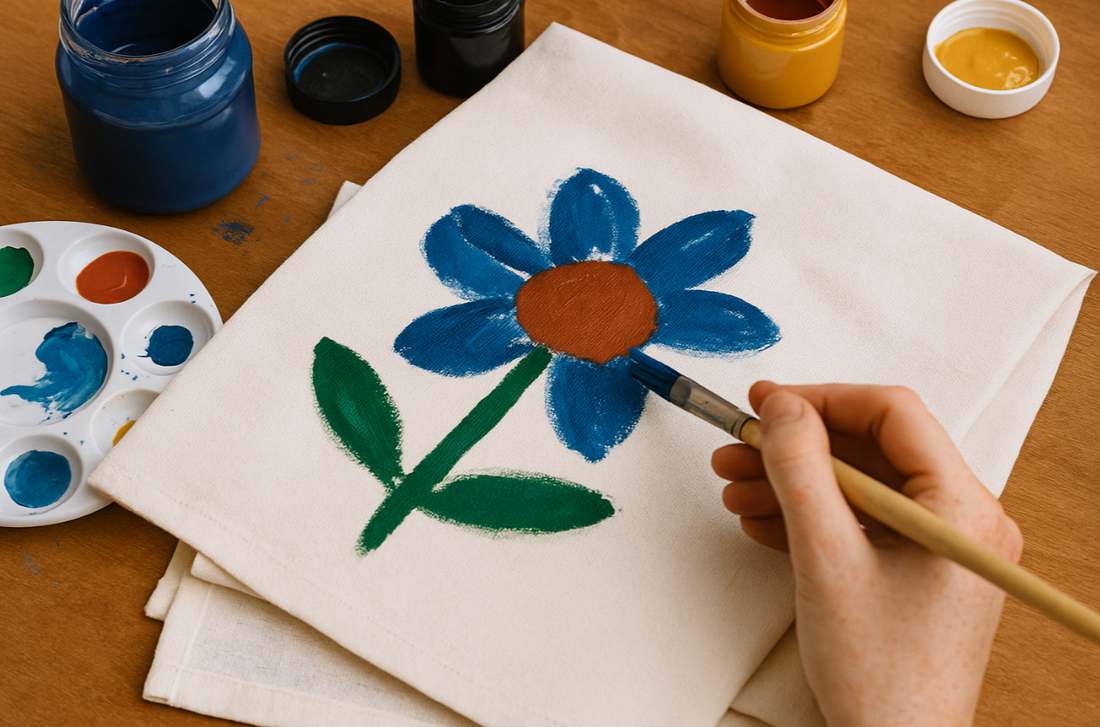
Fabric Paint: History, Types, and How to Make It Last on Any Fabric
From the ancient world to the shelves of modern museums and vintage boutiques, fabric paint has been a bridge between art and utility.
Whether used by artisans in ancient civilizations or by today’s independent brands creating one-of-a-kind tees, fabric painting remains an enduring, expressive form of storytelling.
But how did it all begin? And how do we make sure these painted garments withstand the test of time—and the spin cycle?
The Origin of Fabric Paint: Older Than Paper
Long before paper existed, humans turned to fabric as their canvas.
The earliest known examples of fabric painting date back over 4,000 years to ancient Egypt, India, and China. Natural fibers like linen and silk were painted with mineral-based pigments, extracted from sources like clay, charcoal, crushed beetles, and plant matter.
In ancient India, the Kalamkari technique involved painting on cotton using a bamboo pen and natural dyes. Ancient Egyptians painted shrouds and clothing for ritual and symbolic purposes.
These techniques laid the foundation for today's fabric art practices, blending chemistry, artistry, and culture.

What Makes a Good Fabric Paint?
Painting on fabric is unlike painting on canvas or paper. The material flexes, folds, and moves—and it needs paint that can handle the pressure. For a pigment to work well on fabric, it needs three essential qualities:
- Flexibility: So it doesn’t crack when the fabric bends.
- Adhesion: To bind to the fiber instead of sitting on top.
- Wash-resistance: To stay vibrant even after multiple washes.
Traditional pigments were mixed with natural binders like egg or tree sap. Today, most modern fabric paints are acrylic-based, combining color with a polymer binder to lock the pigment in place after drying.
How to Make Your Fabric Painting Last
Painting a T-shirt is fun, but making sure your work survives laundry day? That’s where technique matters:
- Pre-wash the fabric to remove sizing or finishes that might repel paint.
- Use a fabric medium (if you’re mixing regular acrylic paint) to improve absorption and softness.
- Let it dry completely, then heat-set the paint using an iron or dryer (depending on the brand's instructions).
- Turn the garment inside out when washing, and avoid harsh detergents or hot water.
Different Types of Fabric Paint (And How to Use Them)
1. Acrylic Fabric Paint
- Most common type
- Dries quickly, highly pigmented
- Often used with a fabric medium for flexibility
- Best for cotton, canvas, denim
2. Dye-Based Paints
- Penetrate the fiber instead of sitting on top
- Less texture but often less durable
- Ideal for soft, flowing fabrics like rayon or silk
3. Fabric Markers
- Easy to use and great for detail work
- Perfect for quick sketches or lettering
- Suitable for light-colored, smooth-surfaced cottons
4. Spray Fabric Paint
- Great for stencils, gradients, and abstract styles
- Works well on t-shirts, canvas bags, or jackets
5. Puffy Paint / Dimensional Paint
- Adds texture and 3D effect
- Popular for kids' projects and costume design
Matching Fabric Type to Paint Type
| Fabric Type | Recommended Paint | Notes |
|---|---|---|
| Cotton | Acrylic + Medium | Soft, breathable, holds paint well |
| Silk | Dye-based or Ink Paint | Requires light touch and fixatives |
| Denim | Pure Acrylic Paint | Can handle thick layers |
| Polyester | Fabric spray or dye | May need special bonding agent |
| Rayon | Dye-based Paint | Very absorbent, dries fast |
| Nylon | Fabric Marker or Dye | Needs light, flexible pigment |
Light vs Heavy Fabrics: Handling Differences
- Thin fabrics (like silk or rayon) absorb quickly. Use a light touch, and always test first to avoid bleeding.
- Thicker fabrics (like canvas or denim) can handle more paint and layering. Drying time may be longer, but colors pop more vividly.
Final Thoughts: Fabric Paint as Wearable Art
Today, fabric painting isn’t just a craft—it’s a cultural statement.
From streetwear brands doing limited-edition artist collaborations to museum gift shops selling hand-painted garments, the fusion of clothing and fine art is more alive than ever.
Whether you’re designing a single tee or creating a line of painted pieces, fabric paint invites you to reimagine the very surface of what we wear.
And with the right tools and techniques, that surface becomes a story that lasts.
For more tips on choosing and working with fabrics of all weights, explore our Fabric 101 articles, a great starting point for creators and designers.
